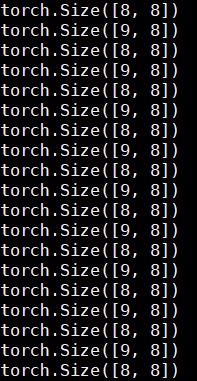ClashNodes
Pytorch单GPU、多GPU训练的几个细节对比
Pytorch单GPU、多GPU训练的区别主要在三个地方:训练前指定GPU、训练过程中保存模型和加载刚刚保存的模型。
训练前指定GPU
单GPU:
os.environ["CUDA_VISIBLE_DEVICES"] = '0' 多GPU:
os.environ["CUDA_VISIBLE_DEVICES"] = '0,1' if torch.cuda.device_count() > 1: print("Let's use", torch.cuda.device_count(), "GPUs!") self.model = nn.DataParallel(self.model) 训练过程中保存模型
单GPU:
state = {'model': self.model.state_dict(), 'epoch': ite} torch.save(state, self.model.name()) 多GPU:
if isinstance(self.model,torch.nn.DataParallel):##判断是否并行 self.model = self.model.module state = {'model': self.model.state_dict(), 'epoch': ite} torch.save(state, self.model.name()) if torch.cuda.device_count() > 1: self.model = nn.DataParallel(self.model) 多加的上面两句是为了解决下面的问题
AttributeError: 'DataParallel' object has no attribute 'name' 如果不加最后两句,也不会报错,但是后面训练都会变成单GPU,也就是会导致下面的结果。(我用的两个GPU)

加上后两句之后:

需要注意前两句、后两句以及原来两句的相对位置不能颠倒,例如把原来的第一句放到最前面,在后面加载模型的时候可能会出现问题。
加载刚刚保存的模型
单GPU:
checkpoint = torch.load(self.model.name()) self.model.load_state_dict(checkpoint['model']) 多GPU改成:
if isinstance(self.model,torch.nn.DataParallel): self.model = self.model.module if torch.cuda.is_available(): #gpu checkpoint = torch.load(self.model.name()) else: #cpu checkpoint = torch.load(self.model.name(),map_location=lambda storage, loc: storage) self.model.load_state_dict(checkpoint['model']) 热门文章
- 美联众合动物医院新街口 美联众合动物医院新街口店
- IntelliJ IDEA配置Maven详解
- 重庆宠物猫领养 重庆宠物猫领养中心
- 流浪猫要养多久才知道健康的情况(流浪小猫多久能养熟)
- 宠物粮批发网站大全免费(宠物粮网店)
- 1月18日|Clash/SSR/Shadowrocket/V2ray每天更新19.2M/S免费节点订阅链接,Clash便宜机场订阅
- Vue滑块验证码组件anji-captcha的使用
- 开宠物食品厂有利润吗知乎 开宠物食品厂有利润吗知乎文章
- 1月30日|Shadowrocket/Clash/SSR/V2ray每天更新22.8M/S免费节点订阅链接,Clash便宜机场订阅
- 1月10日|Shadowrocket/SSR/V2ray/Clash每天更新22.3M/S免费节点订阅链接,Clash便宜机场订阅